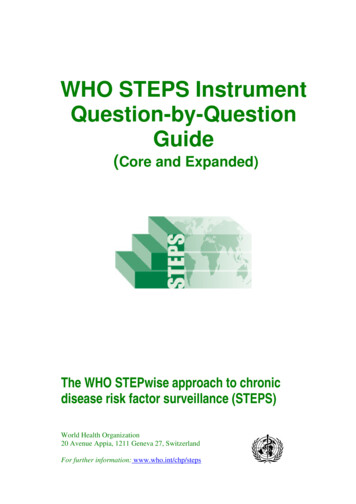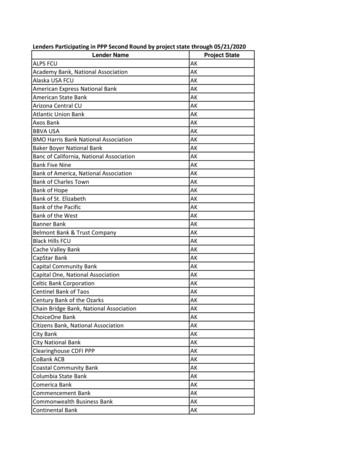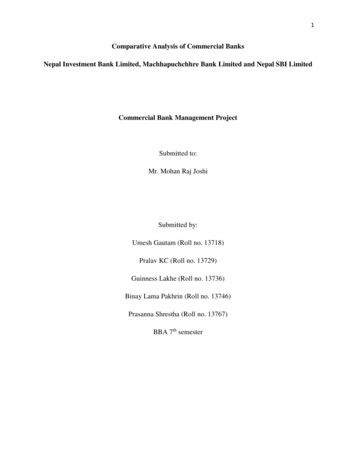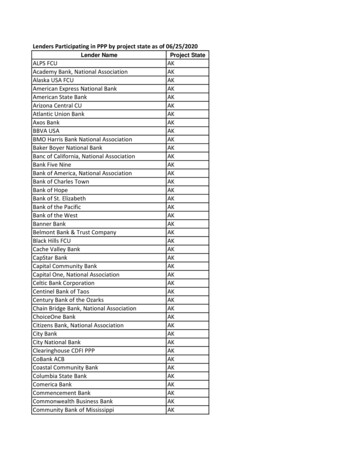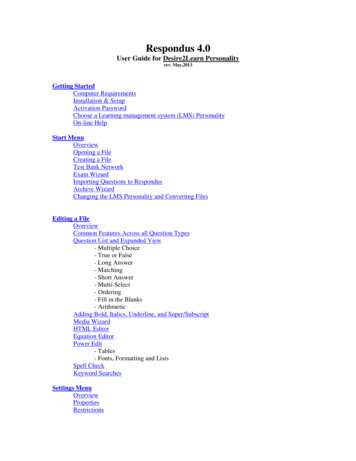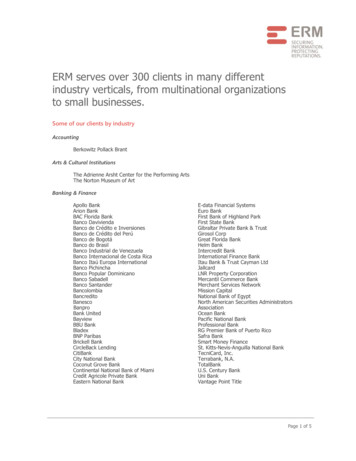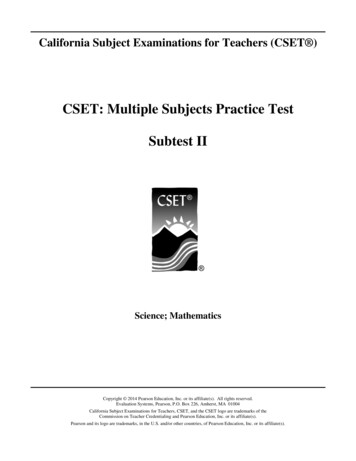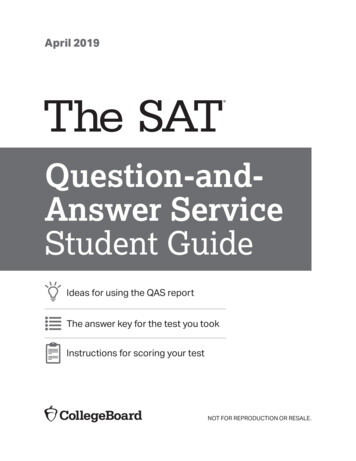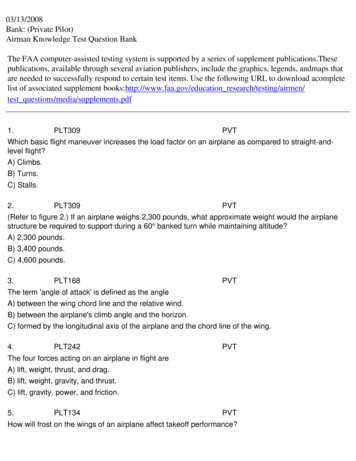
Transcription
03/13/2008Bank: (Private Pilot)Airman Knowledge Test Question BankThe FAA computer-assisted testing system is supported by a series of supplement publications.Thesepublications, available through several aviation publishers, include the graphics, legends, andmaps thatare needed to successfully respond to certain test items. Use the following URL to download acompletelist of associated supplement books:http://www.faa.gov/education research/testing/airmen/test questions/media/supplements.pdf1.PLT309PVTWhich basic flight maneuver increases the load factor on an airplane as compared to straight-andlevel flight?A) Climbs.B) Turns.C) Stalls.2.PLT309PVT(Refer to figure 2.) If an airplane weighs 2,300 pounds, what approximate weight would the airplanestructure be required to support during a 60 banked turn while maintaining altitude?A) 2,300 pounds.B) 3,400 pounds.C) 4,600 pounds.3.PLT168PVTThe term 'angle of attack' is defined as the angleA) between the wing chord line and the relative wind.B) between the airplane's climb angle and the horizon.C) formed by the longitudinal axis of the airplane and the chord line of the wing.4.PLT242PVTThe four forces acting on an airplane in flight areA) lift, weight, thrust, and drag.B) lift, weight, gravity, and thrust.C) lift, gravity, power, and friction.5.PLT134PVTHow will frost on the wings of an airplane affect takeoff performance?
A) Frost will disrupt the smooth flow of air over the wing, adversely affecting its lifting capability.B) Frost will change the camber of the wing, increasing its lifting capability.C) Frost will cause the airplane to become airborne with a higher angle of attack, decreasing thestall speed.6.PLT242PVTWhat force makes an airplane turn?A) The horizontal component of lift.B) The vertical component of lift.C) Centrifugal force.7.PLT243PVTIn what flight condition is torque effect the greatest in a single-engine airplane?A) Low airspeed, high power, high angle of attack.B) Low airspeed, low power, low angle of attack.C) High airspeed, high power, high angle of attack.8.PLT243PVTThe left turning tendency of an airplane caused by P-factor is the result of theA) clockwise rotation of the engine and the propeller turning the airplane counter-clockwise.B) propeller blade descending on the right, producing more thrust than the ascending blade on theleft.C) gyroscopic forces applied to the rotating propeller blades acting 90 in advance of the point theforce was applied.9.PLT351PVTWhat causes an airplane (except a T-tail) to pitch nosedown when power is reduced and controlsare not adjusted?A) The CG shifts forward when thrust and drag are reduced.B) The downwash on the elevators from the propeller slipstream is reduced and elevatoreffectiveness is reduced.C) When thrust is reduced to less than weight, lift is also reduced and the wings can no longersupport the weight.10.PLT213PVTWhat determines the longitudinal stability of an airplane?A) The location of the CG with respect to the center of lift.B) The effectiveness of the horizontal stabilizer, rudder, and rudder trim tab.C) The relationship of thrust and lift to weight and drag.
11.PLT213PVTAn airplane said to be inherently stable willA) be difficult to stall.B) require less effort to control.C) not spin.12.PLT245PVTIn what flight condition must an aircraft be placed in order to spin?A) Partially stalled with one wing low.B) In a steep diving spiral.C) Stalled.13.PLT477PVTAs altitude increases, the indicated airspeed at which a given airplane stalls in a particularconfiguration willA) decrease as the true airspeed decreases.B) decrease as the true airspeed increases.C) remain the same regardless of altitude.14.PLT168PVTThe angle of attack at which an airplane wing stalls willA) increase if the CG is moved forward.B) change with an increase in gross weight.C) remain the same regardless of gross weight.15.PLT194PVTAn ATC radar facility issues the following advisory to a pilot flying north in a calm wind: TRAFFIC 9 O CLOCK, 2 MILES, SOUTHBOUND. Where should the pilot look for this traffic?A) South.B) North.C) West.16.PLT012PVT(Refer to figure 36.) What is the expected fuel consumption for a 1,000-nautical mile flight under thefollowing conditions?Pressure altitude8,000 ftTemperature22 C
Manifold pressure20.8 inches HgWindCalmA) 60.2 gallons.B) 70.1 gallons.C) 73.2 gallons.17.PLT012PVT(Refer to figure 36.) What fuel flow should a pilot expect at 11,000 feet on a standard day with 65percent maximum continuous power?A) 10.6 gallons per hour.B) 11.2 gallons per hour.C) 11.8 gallons per hour.18.PLT124PVT(Refer to figure 8.) What is the effect of a temperature decrease and a pressure altitude increase onthe density altitude from 90 F and 1,250 feet pressure altitude to 55 F and 1,750 feet pressurealtitude?A) 1,300-foot decrease.B) 1,700-foot decrease.C) 1,700-foot increase.19.PLT019PVT(Refer to figure 8.) Determine the pressure altitude at an airport that is 1,386 feet MSL with analtimeter setting of 29.97.A) 1,341 feet MSL.B) 1,451 feet MSL.C) 1,562 feet MSL.20.PLT008(Refer to figure 38.) Determine the approximate total distance required to land over a 50-footobstacle.OAT90 FPressure altitude4,000 ftWeight2,800 lbHeadwind component10 ktsA) 1,525 feet.B) 1,775 feet.C) 1,950 feet.PVT
21.PLT019PVT(Refer to figure 8.) Determine the pressure altitude with an indicated altitude of 1,380 feet MSL withan altimeter setting of 28.22 at standard temperature.A) 2,913 feet MSL.B) 2,991 feet MSL.C) 3,010 feet MSL.22.PLT019PVT(Refer to figure 8.) Determine the pressure altitude at an airport that is 3,563 feet MSL with analtimeter setting of 29.96.A) 3,527 feet MSL.B) 3,556 feet MSL.C) 3,639 feet MSL.23.PLT011PVT(Refer to figure 41.) Determine the total distance required for takeoff to clear a 50-foot obstacle.OATStdPressure altitude4,000 ftTakeoff weight2,800 lbHeadwind componentCalmA) 1,500 feet.B) 1,750 feet.C) 2,000 feet.24.PLT402PVTWhen activated, an emergency locator transmitter (ELT) transmits onA) 118.0 and 118.8 MHz.B) 121.5 and 243.0 MHz.C) 123.0 and 119.0 MHz.25.PLT402PVTWhen must the battery in an emergency locator transmitter (ELT) be replaced (or recharged if thebattery is rechargeable)?A) After one-half the battery's useful life.B) During each annual and 100-hour inspection.C) Every 24 calendar months.26.PLT402PVT
When may an emergency locator transmitter (ELT) be tested?A) Anytime.B) At 15 and 45 minutes past the hour.C) During the first 5 minutes after the hour.27.PLT402PVTWhich procedure is recommended to ensure that the emergency locator transmitter (ELT) has notbeen activated?A) Turn off the aircraft ELT after landing.B) Ask the airport tower if they are receiving an ELT signal.C) Monitor 121.5 before engine shutdown.28.PLT161PVTIf Air Traffic Control advises that radar service is terminated when the pilot is departing Class Cairspace, the transponder should be set to codeA) 0000.B) 1200.C) 4096.29.PLT473PVTOne of the main functions of flaps during approach and landing is toA) decrease the angle of descent without increasing the airspeed.B) permit a touchdown at a higher indicated airspeed.C) increase the angle of descent without increasing the airspeed.30.PLT278PVTWhat is an important airspeed limitation that is not color coded on airspeed indicators?A) Never-exceed speed.B) Maximum structural cruising speed.C) Maneuvering speed.31.PLT088PVT(Refer to figure 4.) What is the maximum structural cruising speed?A) 100 MPH.B) 165 MPH.C) 208 MPH.32.PLT088PVT
(Refer to figure 4.) What is the maximum flaps-extended speed?A) 65 MPH.B) 100 MPH.C) 165 MPH.33.PLT088PVT(Refer to figure 4.) The maximum speed at which the airplane can be operated in smooth air isA) 100 MPH.B) 165 MPH.C) 208 MPH.34.PLT167PVTIf a pilot changes the altimeter setting from 30.11 to 29.96, what is the approximate change inindication?A) Altimeter will indicate .15 inches Hg higher.B) Altimeter will indicate 150 feet higher.C) Altimeter will indicate 150 feet lower.35.PLT165PVTHow do variations in temperature affect the altimeter?A) Pressure levels are raised on warm days and the indicated altitude is lower than true altitude.B) Higher temperatures expand the pressure levels and the indicated altitude is higher than truealtitude.C) Lower temperatures lower the pressure levels and the indicated altitude is lower than truealtitude.36.PLT041PVTAltimeter setting is the value to which the barometric pressure scale of the altimeter is set so thealtimeter indicatesA) calibrated altitude at field elevation.B) absolute altitude at field elevation.C) true altitude at field elevation.37.PLT041(Refer to figure 3.) Altimeter 1 indicatesA) 500 feet.B) 1,500 feet.C) 10,500 feet.PVT
38.PLT166PVTIf it is necessary to set the altimeter from 29.15 to 29.85, what change occurs?A) 70-foot increase in indicated altitude.B) 70-foot increase in density altitude.C) 700-foot increase in indicated altitude.39.PLT023PVTUnder what condition is indicated altitude the same as true altitude?A) If the altimeter has no mechanical error.B) When at sea level under standard conditions.C) When at 18,000 feet MSL with the altimeter set at 29.92.40.PLT023PVTWhat is true altitude?A) The vertical distance of the aircraft above sea level.B) The vertical distance of the aircraft above the surface.C) The height above the standard datum plane.41.PLT023PVTWhat is absolute altitude?A) The altitude read directly from the altimeter.B) The vertical distance of the aircraft above the surface.C) The height above the standard datum plane.42.PLT023PVTWhat is density altitude?A) The height above the standard datum plane.B) The pressure altitude corrected for nonstandard temperature.C) The altitude read directly from the altimeter.43.PLT166PVT(Refer to figure 7.) The proper adjustment to make on the attitude indicator during level flight is toalign theA) horizon bar to the level-flight indication.B) horizon bar to the miniature airplane.C) miniature airplane to the horizon bar.44.PLT132PVT
(Refer to figure 7.) How should a pilot determine the direction of bank from an attitude indicatorsuch as the one illustrated?A) By the direction of deflection of the banking scale (A).B) By the direction of deflection of the horizon bar (B).C) By the relationship of the miniature airplane (C) to the deflected horizon bar (B).45.PLT215PVTIn the Northern Hemisphere, if an aircraft is accelerated or decelerated, the magnetic compass willnormally indicateA) a turn momentarily.B) correctly when on a north or south heading.C) a turn toward the south.46.PLT215PVTIn the Northern Hemisphere, a magnetic compass will normally indicate initially a turn toward thewest ifA) a left turn is entered from a north heading.B) a right turn is entered from a north heading.C) an aircraft is accelerated while on a north heading.47.PLT215PVTDuring flight, when are the indications of a magnetic compass accurate?A) Only in straight-and-level unaccelerated flight.B) As long as the airspeed is constant.C) During turns if the bank does not exceed 18 .48.PLT215PVTIn the Northern Hemisphere, the magnetic compass will normally indicate a turn toward the southwhenA) a left turn is entered from an east heading.B) a right turn is entered from a west heading.C) the aircraft is decelerated while on a west heading.49.PLT187(Refer to figure 5.) A turn coordinator provides an indication of theA) movement of the aircraft about the yaw and roll axis.B) angle of bank up to but not exceeding 30 .C) attitude of the aircraft with reference to the longitudinal axis.PVT
50.PLT337PVTIf the pitot tube and outside static vents become clogged, which instruments would be affected?A) The altimeter, airspeed indicator, and turn-and-slip indicator.B) The altimeter, airspeed indicator, and vertical speed indicator.C) The altimeter, attitude indicator, and turn-and-slip indicator.51.PLT136PVTWith regard to carburetor ice, float-type carburetor systems in comparison to fuel injection systemsare generally considered to beA) more susceptible to icing.B) equally susceptible to icing.C) susceptible to icing only when visible moisture is present.52.PLT190PVTWhich condition is most favorable to the development of carburetor icing?A) Any temperature below freezing and a relative humidity of less than 50 percent.B) Temperature between 32 and 50 F and low humidity.C) Temperature between 20 and 70 F and high humidity.53.PLT249PVTWhile cruising at 9,500 feet MSL, the fuel/air mixture is properly adjusted. What will occur if adescent to 4,500 feet MSL is made without readjusting the mixture?A) The fuel/air mixture may become excessively lean.B) There will be more fuel in the cylinders than is needed for normal combustion, and the excessfuel will absorb heat and cool the engine.C) The excessively rich mixture will create higher cylinder head temperatures and may causedetonation.54.PLT189PVTGenerally speaking, the use of carburetor heat tends toA) decrease engine performance.B) increase engine performance.C) have no effect on engine performance.55.PLT190PVTIf an aircraft is equipped with a fixed-pitch propeller and a float-type carburetor, the first indication ofcarburetor ice would most likely beA) a drop in oil temperature and cylinder head temperature.B) engine roughness.
C) loss of RPM.56.PLT189PVTApplying carburetor heat willA) result in more air going through the carburetor.B) enrich the fuel/air mixture.C) not affect the fuel/air mixture.57.PLT253PVTOn aircraft equipped with fuel pumps, when is the auxiliary electric driven pump used?A) All the time to aid the engine-driven fuel pump.B) In the event engine-driven fuel pump fails.C) Constantly except in starting the engine.58.PLT250PVTIf the grade of fuel used in an aircraft engine is lower than specified for the engine, it will most likelycauseA) a mixture of fuel and air that is not uniform in all cylinders.B) lower cylinder head temperatures.C) detonation.59.PLT478PVTOne purpose of the dual ignition system on an aircraft engine is to provide forA) improved engine performance.B) uniform heat distribution.C) balanced cylinder head pressure.60.PLT115PVTDetonation occurs in a reciprocating aircraft engine whenA) the spark plugs are fouled or shorted out or the wiring is defective.B) hot spots in the combustion chamber ignite the fuel/air mixture in advance of normal ignition.C) the unburned charge in the cylinders explodes instead of burning normally.61.PLT115PVTIf a pilot suspects that the engine (with a fixed-pitch propeller) is detonating during climb-out aftertakeoff, the initial corrective action to take would be toA) lean the mixture.B) lower the nose slightly to increase airspeed.
C) apply carburetor heat.62.PLT478PVTThe uncontrolled firing of the fuel/air charge in advance of normal spark ignition is known asA) combustion.B) pre-ignition.C) detonation.63.PLT343PVTWhat should be the first action after starting an aircraft engine?A) Adjust for proper RPM and check for desired indications on the engine gauges.B) Place the magneto or ignition switch momentarily in the OFF position to check for propergrounding.C) Test each brake and the parking brake.64.PLT343PVTIf the engine oil temperature and cylinder head temperature gauges have exceeded their normaloperating range, the pilot may have been operating withA) the mixture set too rich.B) higher-than-normal oil pressure.C) too much power and with the mixture set too lean.65.PLT253PVTDuring the run-up at a high-elevation airport, a pilot notes a slight engine roughness that is notaffected by the magneto check but grows worse during the carburetor heat check. Under thesecircumstances, what would be the most logical initial action?A) Check the results obtained with a leaner setting of the mixture.B) Taxi back to the flight line for a maintenance check.C) Reduce manifold pressure to control detonation.66.PLT249PVTThe basic purpose of adjusting the fuel/air mixture at altitude is toA) decrease the amount of fuel in the mixture in order to compensate for increased air density.B) decrease the fuel flow in order to compensate for decreased air density.C) increase the amount of fuel in the mixture to compensate for the decrease in pressure anddensity of the air.67.PLT324PVTAn abnormally high engine oil temperature indication may be caused by
A) the oil level being too low.B) operating with a too high viscosity oil.C) operating with an excessively rich mixture.68.PLT351PVTA precaution for the operation of an engine equipped with a constant-speed propeller is toA) avoid high RPM settings with high manifold pressure.B) avoid high manifold pressure settings with low RPM.C) always use a rich mixture with high RPM settings.69.PLT351PVTWhat effect does high density altitude, as compared to low density altitude, have on propellerefficiency and why?A) Efficiency is increased due to less friction on the propeller blades.B) Efficiency is reduced because the propeller exerts less force at high density altitudes than at lowdensity altitudes.C) Efficiency is reduced due to the increased force of the propeller in the thinner air.70.PLT140PVTWhen should pilots decline a land and hold short (LAHSO) clearance?A) Pilots can not decline clearance.B) Only when the tower operator concurs.C) When it will compromise safety.71.PLT140PVTWho should not participate in the Land and Hold Short Operations (LAHSO) program?A) Recreational pilots only.B) Student pilots.C) Military pilots.72.PLT141PVTAn airport's rotating beacon operated during daylight hours indicatesA) there are obstructions on the airport.B) that weather at the airport located in Class D airspace is below basic VFR weather minimums.C) the Air Traffic Control tower is not in operation.73.PLT462PVTTo set the high intensity runway lights on medium intensity, the pilot should click the microphoneseven times, and then click it
A) one time within four seconds.B) three time within three seconds.C) five times within five seconds.74.PLT141PVTAirport taxiway edge lights are identified at night byA) white directional lights.B) blue omnidirectional lights.C) alternate red and green lights.75.PLT147PVT(Refer to figure 48.) Illustration A indicates that the aircraft isA) below the glide slope.B) on the glide slope.C) above the glide slope.76.PLT147PVTAn above glide slope indication from a tri-color VASI isA) a white light signal.B) a green light signal.C) an amber light signal.77.PLT147PVTA below glide slope indication from a tri-color VASI is aA) red light signal.B) pink light signal.C) green light signal.78.PLT077PVT(Refer to figure 49.) Area C on the airport depicted is classified as aA) stabilized area.B) multiple heliport.C) closed runway.79.PLT077PVT(Refer to figure 49.) What is the difference between area A and area E on the airport depicted?A) 'A' may be used for taxi and takeoff; 'E' may be used only as an overrun.
B) 'A' may be used for all operations except heavy aircraft landings; 'E' may be used only as anoverrun.C) 'A' may be used only for taxiing; 'E' may be used for all operations except landings.80.PLT077PVT(Refer to figure 49.) According to the airport diagram, which statement is true?A) Runway 30 is equipped at position E with emergency arresting gear to provide a means ofstopping military aircraft.B) Takeoffs may be started at position A on Runway 12, and the landing portion of this runwaybegins at position B.C) The takeoff and landing portion of Runway 12 begins at position B.81.PLT141PVTThe numbers 9 and 27 on a runway indicate that the runway is oriented approximatelyA) 009 and 027 true.B) 090 and 270 true.C) 090 and 270 magnetic.82.PLT039PVT(Refer to figure 51.) The segmented circle indicates that a landing on Runway 26 will be with aA) right-quartering headwind.B) left-quartering headwind.C) right-quartering tailwind.83.PLT039PVT(Refer to figure 51.) The traffic patterns indicated in the segmented circle have been arranged toavoid flights over an area to theA) south of the airport.B) north of the airport.C) southeast of the airport.84.PLT039PVT(Refer to figure 51.) The segmented circle indicates that the airport traffic isA) left-hand for Runway 36 and right-hand for Runway 18.B) left-hand for Runway 18 and right-hand for Runway 36.C) right-hand for Runway 9 and left-hand for Runway 27.85.PLT077PVT
(Refer to figure 50.) If the wind is as shown by the landing direction indicator, the pilot should landonA) Runway 18 and expect a crosswind from the right.B) Runway 22 directly into the wind.C) Runway 36 and expect a crosswind from the right.86.PLT444PVTDuring the preflight inspection who is responsible for determining the aircraft is safe for flight?A) The pilot in command.B) The certificated mechanic who performed the annual inspection.C) The owner or operator.87.PLT486PVTWhen taxiing with strong quartering tailwinds, which aileron positions should be used?A) Aileron down on the downwind side.B) Ailerons neutral.C) Aileron down on the side from which the wind is blowing.88.PLT112PVT(Refer to figure 9, area A.) How should the flight controls be held while taxiing a tricycle-gearequipped airplane into a left quartering headwind?A) Left aileron up, elevator neutral.B) Left aileron down, elevator neutral.C) Left aileron up, elevator down.89.PLT502PVTIf instructed by ground control to taxi to Runway 9, the pilot may proceedA) via taxiways and across runways to, but not onto, Runway 9.B) to the next intersecting runway where further clearance is required.C) via taxiways and across runways to Runway 9, where an immediate takeoff may be made.90.PLT044PVTAfter landing at a tower-controlled airport, when should the pilot contact ground control?A) When advised by the tower to do so.B) Prior to turning off the runway.C) After reaching a taxiway that leads directly to the parking area.91.PLT150PVT
If the aircraft s radio fails, what is the recommended procedure when landing at a controlled airport?A) Observe the traffic flow, enter the pattern, and look for a light signal from the tower.B) Enter a crosswind leg and rock the wings.C) Flash the landing lights and cycle the landing gear while circling the airport.92.PLT161PVTWhat ATC facility should the pilot contact to receive a special VFR departure clearance in Class Dairspace?A) Automated Flight Service Station.B) Air Traffic Control Tower.C) Air Route Traffic Control Center.93.PLT064PVT(Refer to figure 26, area 3.) If Redbird Tower is not in operation, which frequency should be used asa Common Traffic Advisory Frequency (CTAF) to monitor airport traffic?A) 120.3 MHz.B) 122.95 MHz.C) 126.35 MHz.94.PLT064PVT(Refer to figure 23, area 2; and figure 32.) At Coeur D'Alene , which frequency should be used as aCommon Traffic Advisory Frequency (CTAF) to self-announce position and intentions?A) 122.05 MHz.B) 122.1/108.8 MHz.C) 122.8 MHz.95.PLT064PVT(Refer to figure 23, area 2; and figure 32.) At Coeur D'Alene, which frequency should be used as aCommon Traffic Advisory Frequency (CTAF) to monitor airport traffic?A) 122.05 MHz.B) 135.075 MHz.C) 122.8 MHz.96.PLT064PVT(Refer to figure 23, area 2; and figure 32.) What is the correct UNICOM frequency to be used atCoeur D'Alene to request fuel?A) 135.075 MHz.B) 122.1/108.8 MHz.C) 122.8 MHz.
97.PLT064PVT(Refer to figure 27, area 2.) What is the recommended communication procedure when inbound toland at Cooperstown Airport?A) Broadcast intentions when 10 miles out on the CTAF/MULTICOM frequency, 122.9 MHz.B) Contact UNICOM when 10 miles out on 122.8 MHz.C) Circle the airport in a left turn prior to entering traffic.98.PLT064PVT(Refer to figure 27, area 4.) The CTAF/UNICOM frequency at Jamestown Airport isA) 122.0 MHz.B) 123.0 MHz.C) 123.6 MHz.99.PLT509PVTWhen departing behind a heavy aircraft, the pilot should avoid wake turbulence by maneuvering theaircraftA) below and downwind from the heavy aircraft.B) above and upwind from the heavy aircraft.C) below and upwind from the heavy aircraft.100.PLT509PVTWhen landing behind a large aircraft, the pilot should avoid wake turbulence by stayingA) above the large aircraft's final approach path and landing beyond the large aircraft's touchdownpoint.B) below the large aircraft's final approach path and landing before the large aircraft's touchdownpoint.C) above the large aircraft's final approach path and landing before the large aircraft's touchdownpoint.101.PLT509PVTThe greatest vortex strength occurs when the generating aircraft isA) light, dirty, and fast.B) heavy, dirty, and fast.C) heavy, clean, and slow.102.PLT509PVTWhen taking off or landing at an airport where heavy aircraft are operating, one should beparticularly alert to the hazards of wingtip vortices because this turbulence tends to
A) rise from a crossing runway into the takeoff or landing path.B) rise into the traffic pattern area surrounding the airport.C) sink into the flightpath of aircraft operating below the aircraft generating the turbulence.103.PLT040PVT(Refer to figure 26, area 4.) The floor of Class B airspace overlying Hicks Airport (T67) northnorthwest of Fort Worth Meacham Field isA) at the surface.B) 3,200 feet MSL.C) 4,000 feet MSL.104.PLT040PVT(Refer to figure 26, area 2.) The floor of Class B airspace at Addison Airport isA) at the surface.B) 3,000 feet MSL.C) 3,100 feet MSL.105.PLT161PVTWhich initial action should a pilot take prior to entering Class C airspace?A) Contact approach control on the appropriate frequency.B) Contact the tower and request permission to enter.C) Contact the FSS for traffic advisories.106.PLT161PVTUnder what condition may an aircraft operate from a satellite airport within Class C airspace?A) The pilot must file a flight plan prior to departure.B) The pilot must monitor ATC until clear of the Class C airspace.C) The pilot must contact ATC as soon as practicable after takeoff.107.PLT161PVTAll operations within Class C airspace must be inA) accordance with instrument flight rules.B) compliance with ATC clearances and instructions.C) an aircraft equipped with a 4096-code transponder with Mode C encoding capability.108.PLT161The normal radius of the outer area of Class C airspace isA) 5 nautical miles.PVT
B) 15 nautical miles.C) 20 nautical miles.109.PLT161PVTThe vertical limit of Class C airspace above the primary airport is normallyA) 1,200 feet AGL.B) 3,000 feet AGL.C) 4,000 feet AGL.110.PLT161PVT(Refer to figure 24, area 3.) What is the floor of the Savannah Class C airspace at the shelf area(outer circle)?A) 1,300 feet AGL.B) 1,300 feet MSL.C) 1,700 feet MSL.111.PLT161PVTThe lateral dimensions of Class D airspace are based onA) the number of airports that lie within the Class D airspace.B) 5 statute miles from the geographical center of the primary airport.C) the instrument procedures for which the controlled airspace is established.112.PLT064PVT(Refer to figure 23, area 3.) The vertical limits of that portion of Class E airspace designated as aFederal Airway over Magee Airport areA) 1,200 feet AGL to 17,999 feet MSL.B) 700 feet MSL to 12,500 feet MSL.C) 7,500 feet MSL to 17,999 feet MSL.113.PLT064PVT(Refer to figure 22, area 3.) What type military flight operations should a pilot expect along IR 644?A) IFR training flights above 1,500 feet AGL at speeds in excess of 250 knots.B) VFR training flights above 1,500 feet AGL at speeds less than 250 knots.C) Instrument training flights below 1,500 feet AGL at speeds in excess of 150 knots.114.PLT194PVTAn ATC radar facility issues the following advisory to a pilot flying on a heading of 090 :'TRAFFIC 3 O'CLOCK, 2 MILES, WESTBOUND.'
Where should the pilot look for this traffic?A) East.B) South.C) West.115.PLT444PVTResponsibility for collision avoidance in an alert area rests withA) the controlling agency.B) all pilots.C) Air Traffic Control.116.PLT393PVT(Refer to figure 27, area 2.) What hazards to aircraft may exist in areas, such as Devils Lake EastMOA?A) Unusual, often invisible, hazards to aircraft, such as artillery firing, aerial gunnery, or guidedmissiles.B) Military training activities that necessitate acrobatic or abrupt flight maneuvers.C) High volume of pilot training or an unusual type of aerial activity.117.PLT064PVT(Refer to figure 21 area 4.) What hazards to aircraft may exist in restricted areas such as R-5302B?A) Unusual, often invisible, hazards such as aerial gunnery or guided missiles.B) Military training activities that necessitate acrobatic or abrupt flight maneuvers.C) High volume of pilot training or an unusual type of aerial activity.118.PLT376PVT(Refer to figure 27, area 3.) When flying over Arrowwood National Wildlife Refuge, a pilot should flyno lower thanA) 2,000 feet AGL.B) 2,500 feet AGL.C) 3,000 feet AGL.119.PLT161PVT(Refer to figure 27, area 1.) Identify the airspace over Lowe Airport.A) Class G airspace - surface up to but not including 18,000 feet MSL.B) Class G airspace - surface up to but not including 700 feet MSL, Class E airspace - 700 feet to14,500 feet MSL.C) Class G airspace - surface up to but not including 1,200 feet AGL, Class E airspace - 1,200 feetAGL up to but not including 18,000 feet MSL.
120.PLT123PVTAfter takeoff, which airspeed would the pilot use to gain the most altitude in a given period of time?A) VY.B) VX.C) VA.121.PLT119PVTDuring a night flight, you observe steady red and green lights ahead and at the same altitude. Whatis the general direction of movement of the other aircraft?A) The other aircraft is crossing to the left.B) The other aircraft is flying away from you.C) The other aircraft is approaching head-on.122.PLT119PVTDuring a night flight, you observe a steady white light and a flashing red light ahead and at thesame altitude. What is the general direction of movement of the other aircraft?A) The other aircraft is flying away from you.B) The other aircraft is crossing to the left.C) The other aircraft is crossing to the right.123.PLT194PVTPrior to starting each maneuver, pilots shouldA) check altitude, airspee
Bank: (Private Pilot) Airman Knowledge Test Question Bank The FAA computer-assisted testing system is supported by a series of supplement publications.These publications, available through several aviation publishers, include the graphics, legends, andmaps that
